MELSERVO-JET Series Servo AmplifiersEnhanced functions

MR-JET-G
Supports Ethernet-based CC-Link IE TSN, featuring high-speed, large-capacity communication (1 Gbps).
Command communication cycle of ≥ 125 μs and speed frequency response of 2.5 kHz enable advanced motion control.
The servo amplifiers support linear servo motors in addition to the rotary servo motors.

MR-JET-G-N1
The servo amplifiers support linear servo motors in addition to the rotary servo motors.
MR-JET-G-N1 servo amplifiers support EtherCAT®.
(100 Mbps)
Compact Servo Amplifiers with Simple Wiring
Simple, Efficient Wiring
The servo amplifier offers simple wiring by having connectors on the top and bottom surfaces, and allows all cables and wires to be
routed through wiring ducts. LEDs and switches are located on the front surface of the servo amplifiers for easy operation.
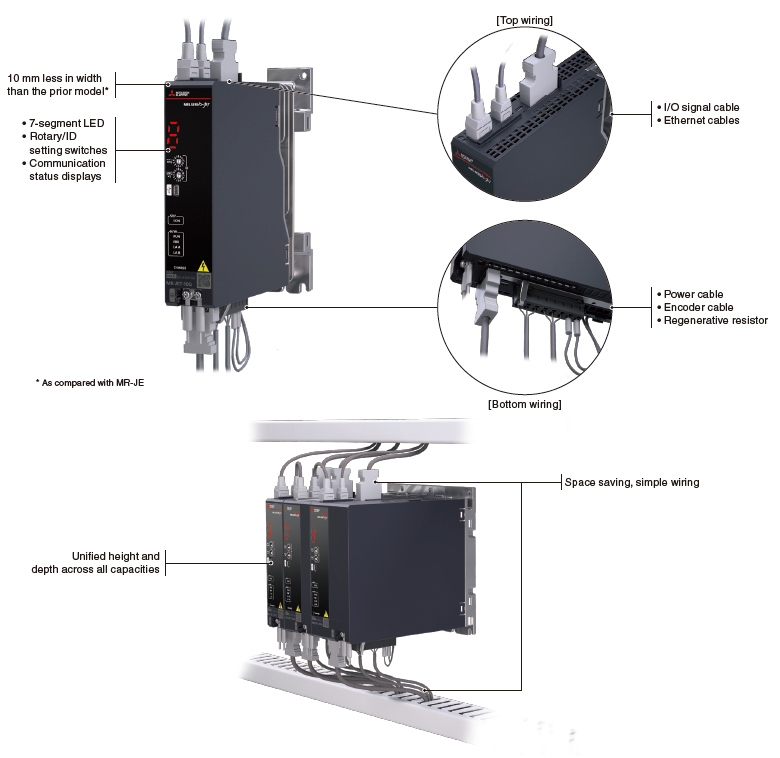
Tuning Functions
Use the tuning methods that are optimal for your machines.
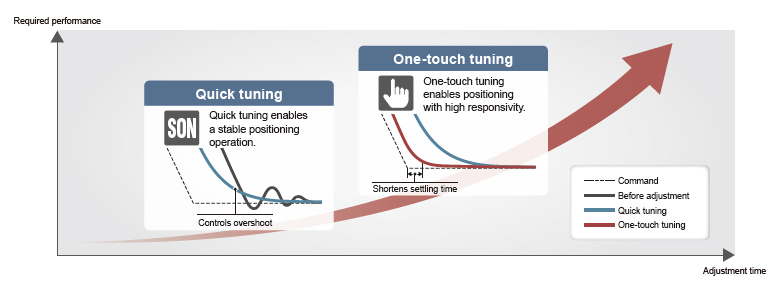
Quick Tuning
This function automatically performs easy-to-use auto tuning that controls vibration and overshoot just by turning on the servo-on command. Before
normal operation, the servo amplifier sets control gain and machine resonance suppression filters in 0.3 seconds by inputting torque to the servo motor automatically. After completing the setting, the servo amplifier starts operation normally.
One-Touch Tuning
This function automatically completes servo gain adjustment according to the mechanical characteristics and reduces the settling time just by turning on the one-touch tuning. The servo gain adjustment includes the machine resonance suppression filter, advanced vibration suppression control II, and the robust filter. Controlling overshoot and vibration is improved, maximizing your machine performance.

Advanced Vibration Suppression Control II
This function suppresses two types of low frequency vibrations, owing to vibration suppression algorithm which supports three-inertia system. This function is effective in suppressing residual vibration with relatively low frequency of approximately 100 Hz or less generated at the end of an arm and in a machine, enabling a shorter settling time. Adjustment is easily performed on MR Configurator2.

Command Notch Filter
The frequency can be set close to the machine vibration frequency because the command notch filter has an applicable frequency range between approximately 1 Hz and 2000 Hz.
Machine Resonance Suppression Filter
The expanded applicable frequency range is between 10 Hz and 8000 Hz. Five filters are simultaneously applicable, improving vibration suppression performance of a machine.
The machine resonance frequency is detected by the machine analyzer function in MR Configurator2.
Preventive Maintenance
Machine Diagnosis Function
This function detects changes in mechanical parts (ball screw, guide, bearing, belt, etc.) by analyzing changes in machine friction, load moment of inertia, unbalanced torque, and vibration components from the data inside a servo amplifier, supporting timely maintenance of these parts.
Servo Amplifier Life Diagnosis
This function displays the cumulative energization time and the number of inrush relay on/off times. The data can be used to check the service life of the parts as a rough guide.
- Cumulative energization time (Smoothing condenser/
cooling fan life span)
- The number of inrush relay on/off times (Inrush relay life)
Corrective Maintenance
Drive RecorderEnhanced
functions
This function continuously monitors the servo status and records the status transition such as a trigger condition before and after an alarm for a fixed period of time. Reading the servo data on MR Configurator2 helps you analyze the cause of the alarm. In addition to the monitor values and the waveform of the past 16-time alarms in the alarm history, the system configuration and the servo parameters are displayed. Alarm occurrence time is also displayed when the servo amplifier and the controller are normally in communication on CC-Link IE TSN.
The data can be outputted to a GX LogViewer format file.
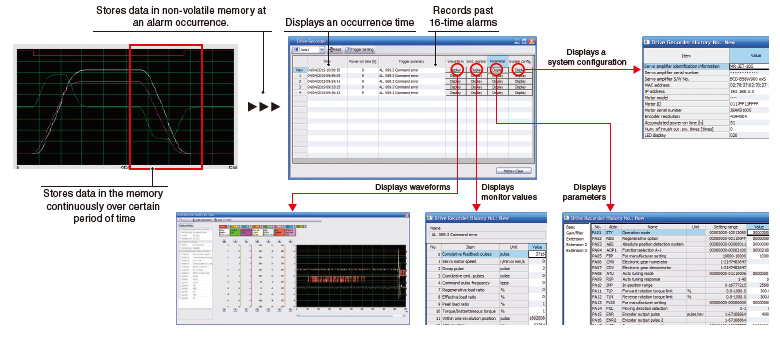
Connection/Communication Diagnosis
Disconnection Detection
The servo amplifiers detect an open phase condition on the output side. The alarm can be distinguished from other alarms such as the overload alarm, reducing the time required to restore the system.
Encoder Communication Diagnosis
The encoder communication diagnosis checks the encoder communication circuit in the servo amplifier. This function is useful for classifying the cause of errors (such as disconnected encoder cables) when the encoder communication alarm occurs.
Path Control
Super Trace Control
This function reduces a position deviation to nearly zero not only during constant-velocity operation, but also during constant acceleration/deceleration.
The path accuracy will be improved in high-rigidity machines.
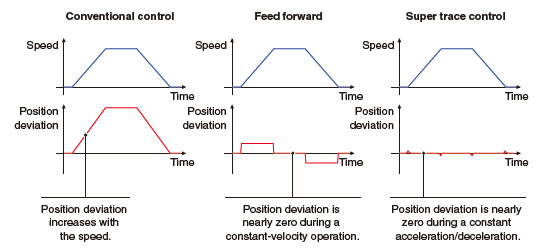
Lost Motion Compensation
This function suppresses quadrant protrusion caused by friction and torsion generated when the servo motor rotates in a reverse direction.
Therefore, the accuracy of circular path will be improved in path control used in XY table, etc.

Path Tracking Model Adaptive Control
This function reduces path errors which occur when the servo motor reciprocates.
Normally, when positioning control is executed, the model adaptive control adjusts the control to shorten a settling time. Instead, this function reduces overshooting to improve path accuracy, which is suitable for machines that require high-accuracy path control such as processing machines.
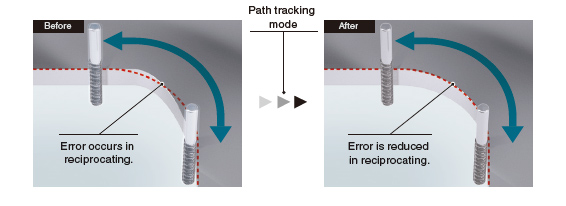
Command Interface
CC-Link IE TSN JET-GEnhanced
functions
The servo amplifiers drive the servo motors by receiving commands (position/velocity/torque) at regular intervals in synchronous communication with the CC-Link IE TSN-compatible controller.
When combined with a Motion module or Motion Control Software, the servo amplifiers enable exact synchronous operation of axes and machines through high-speed, high-precision time synchronization.
The servo amplifiers support CiA 402 drive profile and enable the profile mode (position/velocity/torque) in addition to the cyclic synchronous mode (position/velocity/torque). When combined with the controllers supporting the profile mode, the servo amplifiers generate a positioning command to a target position, reducing loads of the controllers.
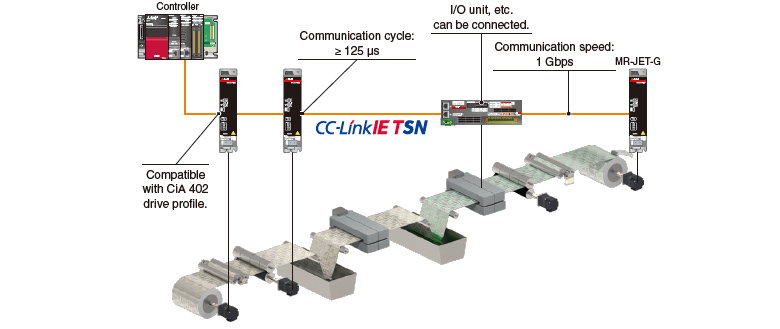
EtherCAT® JET-G-N1Enhanced
functions
Configure an EtherCAT® system with the high-performance MR-JET series servo amplifiers.
MR-JET-G-N1 servo amplifiers support EtherCAT®.
| Communication specification |
CANopen over EtherCAT® (CoE) |
| Drive profile |
CiA 402 |
| Communication cycle |
125 μs, 250 μs, 500 μs,
1 ms, 2 ms, 4 ms, 8 ms |
| Control mode |
Cyclic synchronous position mode (csp) |
| Cyclic synchronous velocity mode (csv) |
| Cyclic synchronous torque mode (cst) |
| Profile position mode (pp) |
| Profile velocity mode (pv) |
| Profile torque mode (tq) |
| Homing mode (hm) |